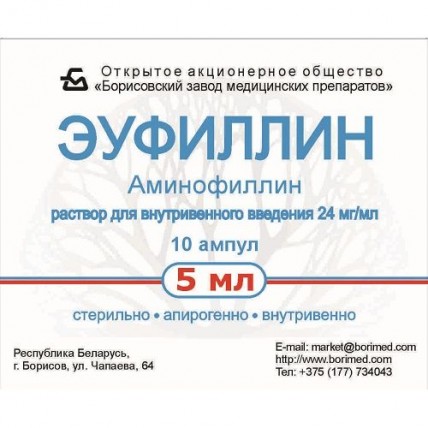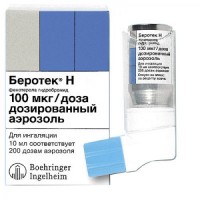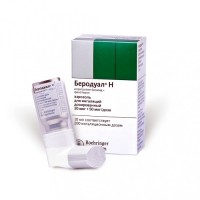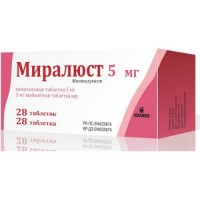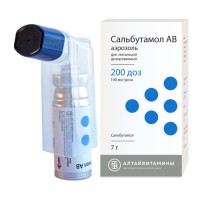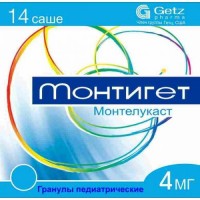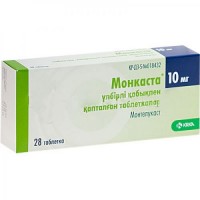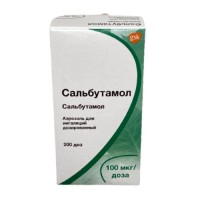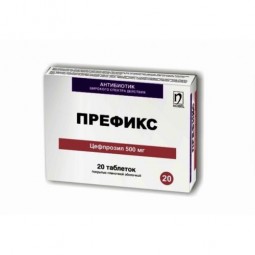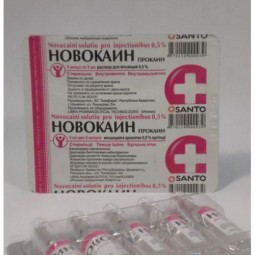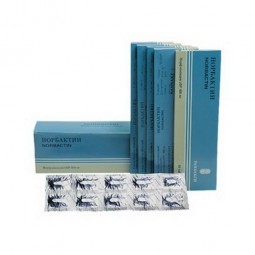Euphyllin (Aminophylline) 2.4%/5 ml, 10 ampoules
- $10.00
The instruction for medical use
of medicine
Euphyllinum
the Trade name
Euphyllinum
the International unlicensed
name Aminophyllinum Dosage Form Solution for intravenous administration of 24 mg/ml
One ampoule (5 ml) contains Structure:
active agent - Aminophyllinum (Euphyllinum) of 120 mg (in terms of anhydrous substance),
excipient - water for injections.
The description
Transparent colourless or slightly yellowish liquid
Pharmacotherapeutic group
Drugs for treatment of obstructive respiratory diseases.
Other drugs for treatment of obstructive respiratory diseases for system use. Xanthines. Aminophyllinum.
The ATX R03DA05 code
the Pharmacological
Pharmacokinetics Later properties of intravenous administration for 60% is in the state connected with blood proteins (in cirrhosis the share of the fraction connected with protein goes down to 35%, and at newborn children this rate is 36%). Well gets through gistogematichesky barriers and it is evenly distributed in blood, extracellular liquid and muscle tissue. In fatty tissue does not collect. Gets through a placental barrier and into mother's milk. The volume of distribution is 0.3-0.7 l/kg (on average 0.45 l/kg).
Bronchodilatory action is shown at maintenance of its concentration in blood plasma at the level of 10-20 mkg/ml. Concentration of Euphyllinum in plasma over 20 mkg/ml is toxic.
Is exposed to intensive metabolism in a liver (about 90%), under influence metilaz and P450 cytochrome partially passes into caffeine. At children up to 3 years the concentration of caffeine can reach 30% of concentration of Euphyllinum. At adults and children is more senior than 3 years of a phenomenon of cumulation of caffeine it is not observed.
It is allocated with kidneys, adults have 10% and children have about 50% - in not changed look. The period of semi-elimination of Euphyllinum (T1/2) at newborns and children up to 6 months is also gt, 24 h, at children 6 months - 3.7 h, at the adults who do not have bronchopulmonary pathology - 8.7 h are more senior. At the persons smoking 20-40 cigarettes a day, T1/2 is shortened up to 4-5 h. At persons with obstructive diseases of lungs, heart failure and a pulmonary heart the period of semi-elimination is extended up to 24 h.
The pharmacodynamics
Renders bronkhodilatiruyushchy, vazodilatiruyushchy, spasmolytic, tokolitichesky and diuretic action.
The mechanism of action is connected with the blocking influence on A2 type of purine receptors of smooth muscle cells. Euphyllinum causes relaxation of smooth muscles of bronchial tubes, coronary, cerebral and pulmonary vessels, muscles of digestive tract and biliary tract. Euphyllinum reduces hyperreactivity of airways in response to intake of allergens in them.
Euphyllinum increases contractility skeletal (including respiratory muscles - diaphragms, intercostal muscles) and slows down development of their exhaustion. Has the stimulating impact on a cardiac muscle, increasing force of its reduction (positive inotropic action). Vasodilatation of renal balls is followed by increase in filtration of blood in kidneys and short-term increase of a diuresis. Stimulates a respiratory center of a medulla, improves alveolar ventilation and causes decrease in frequency and weight of episodes of a night apnoea. Euphyllinum suppresses rhythmic reductions of a pregnant uterus, increases secretion of hydrochloric acid in a stomach, slightly reduces ability of thrombocytes to adhesion and aggregation.
Indications
as a part of complex therapy
- a bronkhoobstruktivny syndrome in bronchial asthma, bronchitis, emphysema of lungs, cardiac asthma (generally for stopping of attacks)
- disturbance of cerebral circulation on ischemic type (as a part of combination therapy)
- hypertensia in a small circle of blood circulation
- a left ventricular failure with a bronchospasm and disturbance of breath as Cheyn-Stokes (as a part of combination therapy)
- the asthmatic status (additional therapy)
the Route of administration and doses
the Adult: enter intravenously slowly (within 4-6 minutes) 5-10 ml 24 mg/ml of solution (0.12 - 0.24 g) which is previously dissolved in 10-20 ml of isotonic solution of sodium of chloride. At emergence of heartbeat, dizziness, nausea slows down rate of administering or passes to drop introduction for what 10-20 ml 24 mg/ml of solution (0.24-0.48) part in 100-150 ml of isotonic solution of sodium of chloride, enters with a speed of 30-50 thaws a minute. Parenterally enter Euphyllinum to 3 times a day, no more than 14 days. The highest doses of Euphyllinum for adults: single - 0.25 g, daily - 0.5 g. At medical emergencies the adult enter intravenously in a dose 6 mg/kg, dissolve 0.9% of NaSI solution in 10 - 20 ml, enter slowly within not less than 5 min. At the asthmatic status it is shown in/in drop introduction - 720-750 mg. Drug is not recommended to children up to 14 years because of side effects.
The highest doses for children intravenously: single – 3 mg/kg, daily – 0.25-0.5 g.
Side effects
- dizziness, a headache, concern, sleep disorders, a tremor, spasms, feeling of inflows suit, the increased sweating
- a stethalgia, heartbeat (tachypnea), disturbance of a warm rhythm, at fast intravenous administration - a stenocardia attack, sharp lowering of the ABP
- anorexia, nausea, vomiting, a gastroesophageal reflux, heartburn, exacerbation of a peptic ulcer, diarrhea
- an albuminuria, a hamaturia, strengthening of a diuresis
- skin allergic reactions (urticaria, exfoliative dermatitis), fever
- a hypoglycemia (in some cases)
- phlebitis in the injection site.
Side effects decrease at a drug dose decline.
Contraindications
- hypersensitivity to Euphyllinum and other methylxanthines
- a sharp phase of a myocardial infarction, heavy coronary insufficiency
- a hypertrophic subaortic stenosis
- the profound arterial hypotension and hypertensia
- a Bouveret's disease, premature ventricular contraction
- a hemorrhagic stroke
- an eye retinal apoplexy
- heavy abnormal liver functions and/or kidneys
- epilepsy
- a thyrotoxicosis, a fluid lungs
- children's age up to 14 years
Medicinal interactions
Ephedrine, β-adrenostimulyator, caffeine and furosemide strengthen effect of drug.
In a combination with phenobarbital, Phenytoinum, rifampicin, an isoniazid, carbamazepine and Sulfinpyrazonum the Euphyllinum metabolism acceleration is observed that is followed by decrease in its effect and can demand increase in the applied drug doses.
At the smoking persons (20-40 cigarettes a day) Euphyllinum metabolism acceleration is also observed.
When assigning in a combination with antibiotics of group of macroleads, lincomycin, Allopyrinolum, Cimetidinum, izoprenaliny, the combined oral contraceptives, Disulfiramum, fluvoksaminy, viloksaziny, anti-influenza vaccines and β-adrenoblockers elimination of drug slows down that is followed by increase in its concentration in plasma and can demand a dose decline.
In case of use of Euphyllinum together with ftorkhinolona the dose of Euphyllinum is reduced up to 1/4 from usually recommended.
At joint administration of xanthines to benzylpenicillin there is its chemical inactivation.
Euphyllinum weakens therapeutic effects of salts of lithium, a pyridoxine and β-adrenoblockers. In turn, prescribing of β-adrenoblockers weakens bronkhodilatiruyushchy effect of Euphyllinum. At intake of Euphyllinum together with β-adrenomimetika, glucocorticosteroids and diuretics the risk of development of a hypoglycemia increases.
Euphyllinum raises a likelihood of development of undesirable effects of mineralokortikosteroid (hypernatremia), the fluorinated derivative anesthetics (ventricular arrhythmias), the means exciting central nervous system (neurotoxicity).
Joint prescribing of xanthines with cardiac glycosides is dangerous by development of intoxication by the last.
Let's combine with spasmolysants, do not apply together with other derivatives of xanthine. At simultaneous use with small doses of ethanol, Disulfiramum, ftorkhinolona, recombinant interferon the alpha, a methotrexate, meksiletiny, propafenony, tibeabendazoly, tiklopidiny, verapamil and at vaccination against flu intensity of effect of Aminophyllinum can increase that can demand decrease in its dose.
Pharmaceutical it is incompatible with solutions of acids, solutions of glucose, fructose and a levuloza. By preparation for infusion it is necessary to consider rn the used solutions.
The special
instructions Use in geriatrics
the Use of Euphyllinum for persons has to is more senior 55 years to be carried out by lower doses of drug.
Drug is appointed with care, under constant observation of the doctor, to the patients having:
- the profound abnormal liver functions and kidneys (liver and/or
renal failure)
- a peptic ulcer of a stomach and duodenum in the anamnesis
- bleedings from digestive tract in the anamnesis
- heavy coronary insufficiency
- widespread atherosclerosis of vessels
- frequent ventricular premature ventricular contraction
- the increased convulsive readiness
- an uncontrollable hypothyroidism (possibility of cumulation) or
a thyrotoxicosis
- sepsis, a long hyperthermia
- a gastroesophageal reflux
- a prostatauxe.
Euphyllinum is not applied along with other derivatives of xanthine.
During treatment it is necessary to avoid consumption of the foodstuff and drinks containing xanthine derivatives (strong tea, coffee, chocolate, cocoa, a mat).
Pregnancy and a lactation
can lead Use of Euphyllinum at pregnancy to creation in an organism of the newborn and a fruit of potentially dangerous concentration of theophylline and caffeine. Newborns whose mothers during pregnancy (especially in the III trimester) received Euphyllinum need medical observation for control of possible symptoms of intoxication methylxanthines. Prescribing of drug during pregnancy and a lactation demands assessment of potential risk for the child and is made only according to extreme vital indications. Breastfeeding during administration of drug should be stopped.
Features of influence of medicine on ability to run the vehicle or potentially dangerous mechanisms
Considering side effects of drug, it is necessary to refrain during treatment for control of motor transport and occupations potentially dangerous types of activity demanding the increased concentration of attention and speed of psychomotor reactions
Overdose
Symptoms: arise at concentration of drug in plasma more than 20 mkg/ml. Long vomiting, diarrhea, hyperaemia of the person, arrhythmia, excitement, a photophobia, a tremor and spasms, a hyperventilation, a sharp lowering of arterial pressure is characteristic. At level over 40 mkg/ml develop in blood a coma.
Treatment: measures of the help include drug withdrawal, an artificial diuresis using loopback diuretics: furosemide, a trosemid, at level more than 50 mkg/ml - hemosorption, a plasma exchange are shown. The hemodialysis or peritoneal dialysis are ineffective. At a convulsive syndrome - intramuscular administration of diazepam (barbiturates are contraindicated!). For stopping of arrhythmias use intravenous administration of lidocaine or verapamil. In vomiting use intravenous administration of Metoclopramidum or an ondansetron. Use as antiemetics of an etaperazin or other neuroleptics contraindicated! As specific antidote in intoxication Euphyllinum use intravenous jet administration of inosine (inositol) in isotonic solution of sodium of chloride (it is not necessary to use solutions of glucose or a dextrose for cultivation).
The form of release and packing
On 5 ml of drug place in ampoules from glass. On 10 ampoules together with a knife or the scarificator for opening of ampoules put in a box of cardboard with a corrugated insert from paper for corrugation. The box is pasted over with the label parcel post from paper offset or papers for the polichromatic press, or printing paper. Boxes together with the instruction for medical use in the state and Russian languages pack into group packing.
The number of instructions for medical use in the state and Russian languages has to correspond to the number of packs.
On 5 ampoules place in an insert from a film polyvinylchloride. On 2 inserts with ampoules together with a knife for opening of ampoules and with iinstruktion on medical use in the state and Russian languages put in a pack from cardboard for a retail container.
10 ampoules together with a knife or the scarificator for opening of ampoules and iinstruktion on medical use in the state and Russian languages place in a pack from cardboard with a cardboard insert for fixing of ampoules.
Packs pack into group packing.
In case of use of ampoules with a ring of a break or a notch and a point of a break, the knife investment for opening of ampoules is not provided.
To Store storage conditions in the place protected from light, at a temperature not above 25 °C.
To store out of children's reach!
2 years
not to use a period of storage after an expiration date.
Prescription status
According to the prescription
the Producer/packer
"Borisovsky Plant of Medications" Open joint stock company, Republic of Belarus, Minsk Region, Borisov, Chapayev St., 64, ph. / fax 8-(10375177) 734043.
The owner of the registration certificate
"Borisovsky Plant of Medications" Open joint stock company, Republic of Belarus
to Develop the Address of the organization accepting in the territory of the Republic of Kazakhstan claims from consumers on quality of products (goods) "Borisovsky Plant of Medications" Open joint stock company, Republic of Belarus, Minsk Region, Borisov, Chapayev St., 64, ph. / fax 8-(10375177) 734043, the e-mail address of market@borimed.com
of medicine
Euphyllinum
the Trade name
Euphyllinum
the International unlicensed
name Aminophyllinum Dosage Form Solution for intravenous administration of 24 mg/ml
One ampoule (5 ml) contains Structure:
active agent - Aminophyllinum (Euphyllinum) of 120 mg (in terms of anhydrous substance),
excipient - water for injections.
The description
Transparent colourless or slightly yellowish liquid
Pharmacotherapeutic group
Drugs for treatment of obstructive respiratory diseases.
Other drugs for treatment of obstructive respiratory diseases for system use. Xanthines. Aminophyllinum.
The ATX R03DA05 code
the Pharmacological
Pharmacokinetics Later properties of intravenous administration for 60% is in the state connected with blood proteins (in cirrhosis the share of the fraction connected with protein goes down to 35%, and at newborn children this rate is 36%). Well gets through gistogematichesky barriers and it is evenly distributed in blood, extracellular liquid and muscle tissue. In fatty tissue does not collect. Gets through a placental barrier and into mother's milk. The volume of distribution is 0.3-0.7 l/kg (on average 0.45 l/kg).
Bronchodilatory action is shown at maintenance of its concentration in blood plasma at the level of 10-20 mkg/ml. Concentration of Euphyllinum in plasma over 20 mkg/ml is toxic.
Is exposed to intensive metabolism in a liver (about 90%), under influence metilaz and P450 cytochrome partially passes into caffeine. At children up to 3 years the concentration of caffeine can reach 30% of concentration of Euphyllinum. At adults and children is more senior than 3 years of a phenomenon of cumulation of caffeine it is not observed.
It is allocated with kidneys, adults have 10% and children have about 50% - in not changed look. The period of semi-elimination of Euphyllinum (T1/2) at newborns and children up to 6 months is also gt, 24 h, at children 6 months - 3.7 h, at the adults who do not have bronchopulmonary pathology - 8.7 h are more senior. At the persons smoking 20-40 cigarettes a day, T1/2 is shortened up to 4-5 h. At persons with obstructive diseases of lungs, heart failure and a pulmonary heart the period of semi-elimination is extended up to 24 h.
The pharmacodynamics
Renders bronkhodilatiruyushchy, vazodilatiruyushchy, spasmolytic, tokolitichesky and diuretic action.
The mechanism of action is connected with the blocking influence on A2 type of purine receptors of smooth muscle cells. Euphyllinum causes relaxation of smooth muscles of bronchial tubes, coronary, cerebral and pulmonary vessels, muscles of digestive tract and biliary tract. Euphyllinum reduces hyperreactivity of airways in response to intake of allergens in them.
Euphyllinum increases contractility skeletal (including respiratory muscles - diaphragms, intercostal muscles) and slows down development of their exhaustion. Has the stimulating impact on a cardiac muscle, increasing force of its reduction (positive inotropic action). Vasodilatation of renal balls is followed by increase in filtration of blood in kidneys and short-term increase of a diuresis. Stimulates a respiratory center of a medulla, improves alveolar ventilation and causes decrease in frequency and weight of episodes of a night apnoea. Euphyllinum suppresses rhythmic reductions of a pregnant uterus, increases secretion of hydrochloric acid in a stomach, slightly reduces ability of thrombocytes to adhesion and aggregation.
Indications
as a part of complex therapy
- a bronkhoobstruktivny syndrome in bronchial asthma, bronchitis, emphysema of lungs, cardiac asthma (generally for stopping of attacks)
- disturbance of cerebral circulation on ischemic type (as a part of combination therapy)
- hypertensia in a small circle of blood circulation
- a left ventricular failure with a bronchospasm and disturbance of breath as Cheyn-Stokes (as a part of combination therapy)
- the asthmatic status (additional therapy)
the Route of administration and doses
the Adult: enter intravenously slowly (within 4-6 minutes) 5-10 ml 24 mg/ml of solution (0.12 - 0.24 g) which is previously dissolved in 10-20 ml of isotonic solution of sodium of chloride. At emergence of heartbeat, dizziness, nausea slows down rate of administering or passes to drop introduction for what 10-20 ml 24 mg/ml of solution (0.24-0.48) part in 100-150 ml of isotonic solution of sodium of chloride, enters with a speed of 30-50 thaws a minute. Parenterally enter Euphyllinum to 3 times a day, no more than 14 days. The highest doses of Euphyllinum for adults: single - 0.25 g, daily - 0.5 g. At medical emergencies the adult enter intravenously in a dose 6 mg/kg, dissolve 0.9% of NaSI solution in 10 - 20 ml, enter slowly within not less than 5 min. At the asthmatic status it is shown in/in drop introduction - 720-750 mg. Drug is not recommended to children up to 14 years because of side effects.
The highest doses for children intravenously: single – 3 mg/kg, daily – 0.25-0.5 g.
Side effects
- dizziness, a headache, concern, sleep disorders, a tremor, spasms, feeling of inflows suit, the increased sweating
- a stethalgia, heartbeat (tachypnea), disturbance of a warm rhythm, at fast intravenous administration - a stenocardia attack, sharp lowering of the ABP
- anorexia, nausea, vomiting, a gastroesophageal reflux, heartburn, exacerbation of a peptic ulcer, diarrhea
- an albuminuria, a hamaturia, strengthening of a diuresis
- skin allergic reactions (urticaria, exfoliative dermatitis), fever
- a hypoglycemia (in some cases)
- phlebitis in the injection site.
Side effects decrease at a drug dose decline.
Contraindications
- hypersensitivity to Euphyllinum and other methylxanthines
- a sharp phase of a myocardial infarction, heavy coronary insufficiency
- a hypertrophic subaortic stenosis
- the profound arterial hypotension and hypertensia
- a Bouveret's disease, premature ventricular contraction
- a hemorrhagic stroke
- an eye retinal apoplexy
- heavy abnormal liver functions and/or kidneys
- epilepsy
- a thyrotoxicosis, a fluid lungs
- children's age up to 14 years
Medicinal interactions
Ephedrine, β-adrenostimulyator, caffeine and furosemide strengthen effect of drug.
In a combination with phenobarbital, Phenytoinum, rifampicin, an isoniazid, carbamazepine and Sulfinpyrazonum the Euphyllinum metabolism acceleration is observed that is followed by decrease in its effect and can demand increase in the applied drug doses.
At the smoking persons (20-40 cigarettes a day) Euphyllinum metabolism acceleration is also observed.
When assigning in a combination with antibiotics of group of macroleads, lincomycin, Allopyrinolum, Cimetidinum, izoprenaliny, the combined oral contraceptives, Disulfiramum, fluvoksaminy, viloksaziny, anti-influenza vaccines and β-adrenoblockers elimination of drug slows down that is followed by increase in its concentration in plasma and can demand a dose decline.
In case of use of Euphyllinum together with ftorkhinolona the dose of Euphyllinum is reduced up to 1/4 from usually recommended.
At joint administration of xanthines to benzylpenicillin there is its chemical inactivation.
Euphyllinum weakens therapeutic effects of salts of lithium, a pyridoxine and β-adrenoblockers. In turn, prescribing of β-adrenoblockers weakens bronkhodilatiruyushchy effect of Euphyllinum. At intake of Euphyllinum together with β-adrenomimetika, glucocorticosteroids and diuretics the risk of development of a hypoglycemia increases.
Euphyllinum raises a likelihood of development of undesirable effects of mineralokortikosteroid (hypernatremia), the fluorinated derivative anesthetics (ventricular arrhythmias), the means exciting central nervous system (neurotoxicity).
Joint prescribing of xanthines with cardiac glycosides is dangerous by development of intoxication by the last.
Let's combine with spasmolysants, do not apply together with other derivatives of xanthine. At simultaneous use with small doses of ethanol, Disulfiramum, ftorkhinolona, recombinant interferon the alpha, a methotrexate, meksiletiny, propafenony, tibeabendazoly, tiklopidiny, verapamil and at vaccination against flu intensity of effect of Aminophyllinum can increase that can demand decrease in its dose.
Pharmaceutical it is incompatible with solutions of acids, solutions of glucose, fructose and a levuloza. By preparation for infusion it is necessary to consider rn the used solutions.
The special
instructions Use in geriatrics
the Use of Euphyllinum for persons has to is more senior 55 years to be carried out by lower doses of drug.
Drug is appointed with care, under constant observation of the doctor, to the patients having:
- the profound abnormal liver functions and kidneys (liver and/or
renal failure)
- a peptic ulcer of a stomach and duodenum in the anamnesis
- bleedings from digestive tract in the anamnesis
- heavy coronary insufficiency
- widespread atherosclerosis of vessels
- frequent ventricular premature ventricular contraction
- the increased convulsive readiness
- an uncontrollable hypothyroidism (possibility of cumulation) or
a thyrotoxicosis
- sepsis, a long hyperthermia
- a gastroesophageal reflux
- a prostatauxe.
Euphyllinum is not applied along with other derivatives of xanthine.
During treatment it is necessary to avoid consumption of the foodstuff and drinks containing xanthine derivatives (strong tea, coffee, chocolate, cocoa, a mat).
Pregnancy and a lactation
can lead Use of Euphyllinum at pregnancy to creation in an organism of the newborn and a fruit of potentially dangerous concentration of theophylline and caffeine. Newborns whose mothers during pregnancy (especially in the III trimester) received Euphyllinum need medical observation for control of possible symptoms of intoxication methylxanthines. Prescribing of drug during pregnancy and a lactation demands assessment of potential risk for the child and is made only according to extreme vital indications. Breastfeeding during administration of drug should be stopped.
Features of influence of medicine on ability to run the vehicle or potentially dangerous mechanisms
Considering side effects of drug, it is necessary to refrain during treatment for control of motor transport and occupations potentially dangerous types of activity demanding the increased concentration of attention and speed of psychomotor reactions
Overdose
Symptoms: arise at concentration of drug in plasma more than 20 mkg/ml. Long vomiting, diarrhea, hyperaemia of the person, arrhythmia, excitement, a photophobia, a tremor and spasms, a hyperventilation, a sharp lowering of arterial pressure is characteristic. At level over 40 mkg/ml develop in blood a coma.
Treatment: measures of the help include drug withdrawal, an artificial diuresis using loopback diuretics: furosemide, a trosemid, at level more than 50 mkg/ml - hemosorption, a plasma exchange are shown. The hemodialysis or peritoneal dialysis are ineffective. At a convulsive syndrome - intramuscular administration of diazepam (barbiturates are contraindicated!). For stopping of arrhythmias use intravenous administration of lidocaine or verapamil. In vomiting use intravenous administration of Metoclopramidum or an ondansetron. Use as antiemetics of an etaperazin or other neuroleptics contraindicated! As specific antidote in intoxication Euphyllinum use intravenous jet administration of inosine (inositol) in isotonic solution of sodium of chloride (it is not necessary to use solutions of glucose or a dextrose for cultivation).
The form of release and packing
On 5 ml of drug place in ampoules from glass. On 10 ampoules together with a knife or the scarificator for opening of ampoules put in a box of cardboard with a corrugated insert from paper for corrugation. The box is pasted over with the label parcel post from paper offset or papers for the polichromatic press, or printing paper. Boxes together with the instruction for medical use in the state and Russian languages pack into group packing.
The number of instructions for medical use in the state and Russian languages has to correspond to the number of packs.
On 5 ampoules place in an insert from a film polyvinylchloride. On 2 inserts with ampoules together with a knife for opening of ampoules and with iinstruktion on medical use in the state and Russian languages put in a pack from cardboard for a retail container.
10 ampoules together with a knife or the scarificator for opening of ampoules and iinstruktion on medical use in the state and Russian languages place in a pack from cardboard with a cardboard insert for fixing of ampoules.
Packs pack into group packing.
In case of use of ampoules with a ring of a break or a notch and a point of a break, the knife investment for opening of ampoules is not provided.
To Store storage conditions in the place protected from light, at a temperature not above 25 °C.
To store out of children's reach!
2 years
not to use a period of storage after an expiration date.
Prescription status
According to the prescription
the Producer/packer
"Borisovsky Plant of Medications" Open joint stock company, Republic of Belarus, Minsk Region, Borisov, Chapayev St., 64, ph. / fax 8-(10375177) 734043.
The owner of the registration certificate
"Borisovsky Plant of Medications" Open joint stock company, Republic of Belarus
to Develop the Address of the organization accepting in the territory of the Republic of Kazakhstan claims from consumers on quality of products (goods) "Borisovsky Plant of Medications" Open joint stock company, Republic of Belarus, Minsk Region, Borisov, Chapayev St., 64, ph. / fax 8-(10375177) 734043, the e-mail address of market@borimed.com
